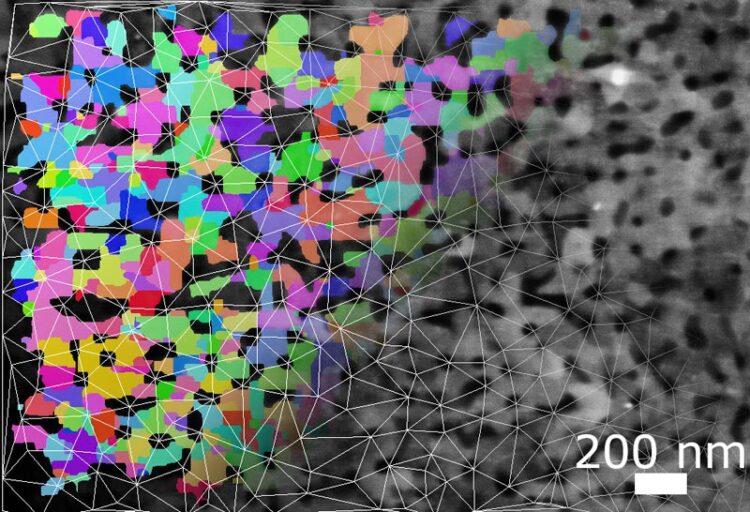Thermal insulation for quantum technologies

Electron microscope image of a silicon sample with nanocrystallites of different orientation (coloured), pores (black) and the pore network recognised by the image processing software (white grid lines).
Credit: D. Kojda / HZB
Thermal insulation is not only important for buildings, but also in quantum technologies. While insulation panels around a house keep the heat inside, quantum devices require insulation against heat from the outside world, as many quantum effects are only stable at low temperatures. What is needed are materials with extremely low thermal conductivity that are also compatible with the materials used in quantum technology.
Novel sintering process
A team led by Dr Klaus Habicht from HZB has now taken a big step forward in this direction. Using a novel sintering process, they produced samples of silicon and silicon aluminium that were compacted under pressure and an electric field for a few minutes at high temperature. Before that, further microstructures were added to the Si starting material using electrochemical etching processes, which further suppress heat transport. “Silicon is the ideal material here for many reasons, in particular it fits possible devices based on silicon qubits,” Habicht points out.
Obstacles for phonon transport
This gave them a number of material samples with tiny pores, crystalline nanoparticles and so-called domain boundaries. Heat conduction works via vibrations of the crystal lattice, so called phonons. However, these phonons can only propagate if they do not encounter obstacles on which they are scattered. Pores as well as nanoparticles and domain boundaries with suitable distances and diameters can become such scattering centres and thus reduce heat conduction.
Separating the contributions
Using an elegant model, the scientists calculated the behaviour of the phonons and thus the thermal conductivity in different samples. Their microstructure was incorporated with parameters such as the size and spacing of pores and nanoparticles. “With this model, we can clearly separate the contributions of nanoparticles and pores to thermal conductivity,” Habicht explains.
Microstructures evaluated in detail
The experimental results on microstructures and thermal conductivity in the individual samples confirm the new model. First author Danny Kojda determined the microstructures at the HZB’s scanning electron microscope. Using special image analysis software, developed by Kojda for this purpose, he determined the size and number of nanoparticles and pores, as well as their spacing. The thermal conductivity as a function of temperature was carefully measured in all samples. The measured data matched the modelled results extremely well. This means that it is now possible to determine whether, in a sample with a given microstructure, it is mainly the pores or rather the nanocrystallites that are responsible for the suppression of heat conduction.
Materials design
“Understanding the basic transport processes helps us to produce and further develop customised materials with strongly reduced thermal conductivity in a targeted manner,” says Kojda.
Journal: Nano Research
DOI: 10.1007/s12274-022-4123-y
Method of Research: Experimental study
Subject of Research: Not applicable
Article Title: Characterization and modeling of the temperature-dependent thermal conductivity in sintered porous silicon-aluminum nanomaterials
COI Statement: none
Media Contact
Antonia Roetger
Helmholtz-Zentrum Berlin für Materialien und Energie
antonia.roetger@helmholtz-berlin.de
Office: 0049-308-062-43733
All latest news from the category: Physics and Astronomy
This area deals with the fundamental laws and building blocks of nature and how they interact, the properties and the behavior of matter, and research into space and time and their structures.
innovations-report provides in-depth reports and articles on subjects such as astrophysics, laser technologies, nuclear, quantum, particle and solid-state physics, nanotechnologies, planetary research and findings (Mars, Venus) and developments related to the Hubble Telescope.
Newest articles

Pinpointing hydrogen isotopes in titanium hydride nanofilms
Although it is the smallest and lightest atom, hydrogen can have a big impact by infiltrating other materials and affecting their properties, such as superconductivity and metal-insulator-transitions. Now, researchers from…

A new way of entangling light and sound
For a wide variety of emerging quantum technologies, such as secure quantum communications and quantum computing, quantum entanglement is a prerequisite. Scientists at the Max-Planck-Institute for the Science of Light…

Telescope for NASA’s Roman Mission complete, delivered to Goddard
NASA’s Nancy Grace Roman Space Telescope is one giant step closer to unlocking the mysteries of the universe. The mission has now received its final major delivery: the Optical Telescope…



